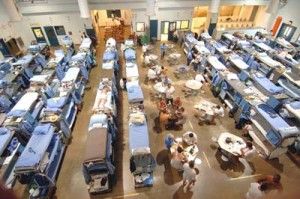How California Prisons Got So Bad
by Steven Greenhut | May 30, 2011 7:55 am
 [1]MAY 30, 2011
[1]MAY 30, 2011
In the Assembly last week, legislators praised ethnic studies departments and had long-winded debates before voting to ban the trading of shark fins in California. But while state government becomes ever-more meddlesome in ever-expanding areas of private life, it’s increasingly clear that the Legislature and the state bureaucracies are incapable of handling even the most basic and important responsibilities that come before them.
One of the basics is public safety. Government is not supposed to manage the economy and social engineer our lives, but it is supposed to arrest and lock up criminals. But the U.S. Supreme Court had to step in last week because the state government’s handling of the prison system has become abusive and unconstitutional. As the court explained, “California’s prisons are designed to house a population just under 80,000, but at the time of the [case being decided] the population was almost double that.”
Years go by, and nothing changes in the state prison system. The conditions are horrendous. No one is thrilled to have the Supreme Court step in and order the state to (potentially) release inmates — a frightening prospect that could, as dissenting Justice Samuel Alito put it, amount to “gambling with the safety of the people of California.” The court ordered the state to reduce its prison population by 30,000 inmates, to bring it down to 137.5 percent of the system’s capacity.
There are various ways of achieving this beyond just putting violent felons on the street. Prisoners could be housed in county jails, for instance, but, knowing how the state government operates, it’s likely that many prisoners will be released — and it’s not likely to be only those who are suffering medical problems, given the inability of bureaucrats to make meaningful distinctions.
Overcrowding
“The Supreme Court today chose to ignore the devastating impact that a population cap would have on our communities and instead paved the way for the early release of tens of thousands of dangerous criminals,” said Assembly Republican Leader Connie Conway of Tulare. “This is an example of legislating from the bench at its worst.”
But as the court’s timeline makes clear, California officials have for years known that the prison system at times resembles a torture chamber. Justice Anthony Kennedy, siding with the four more liberal justices, wrote an impassioned majority opinion that detailed the dismal state of affairs: “Because of a shortage of treatment beds, suicidal inmates may be held for prolonged periods in telephone-booth-size cages without toilets. A psychiatric expert reported observing an inmate who had been held in such a cage for nearly 24 hours, standing in a pool of his own urine, unresponsive and nearly catatonic. Prison officials explained they had ‘no place to put him.'”
This certainly fits the definition of cruel and unusual punishment. Does anyone believe that had the court not intervened that there would be any resolution to this problem?
Just because prisoners violated the social contract doesn’t mean that they should be treated like rats. Even though most prisoners are not worthy of much sympathy doesn’t mean they should be subjected to the kind of abuses that are common.
Conservatives — who claim to be about limiting government power – should likewise be concerned. They should do more than grandstand the law-and-order issue; not that Democrats have been any better. Most Democrats have not cared about civil liberties as they court favor with the unions, which want nothing more than to protect their members from accountability. A Stanford study[2] from a few years back documented the way the prison guards union has driven state crime policy and has resisted meaningful reforms that would improve prison conditions and reduce the burden to taxpayers.
The problem lies with state government’s nearly criminal incompetence. As Sen. Doug LaMalfa, R-Richvale, explained, “The Legislature acted in 2007 to pass a $3.5 billion bond package to finance the construction of new prisons, yet four years later not a single new facility has been built. Bureaucracy and failure to act has caused the construction projects to stall and lead the state to this court decision.
“While I disagree completely with the ruling, I’m not surprised with the court’s action, as California was warned in 2007. The past administration and the Department of Corrections and Rehabilitation’s purposeful inaction have brought us to this day,” LaMalfa said. “Now is the time for a sober assessment and action — not more stalling and calling for taxes. There is no reason why California needs to spend twice as much per prisoner to incarcerate felons than other states.”
Incompetence and Bureaucracy
This situation, indeed, is the result of the incompetence and inaction of the state bureaucracy. The money was there to build new prisons. It’s also time to talk of sentencing reform, given the numbers of Californians jailed as part of the drug war and other nonviolent activity.
California’s lack of prison space is in part driven by our excessively high costs of imprisoning inmates — $49,000 per inmate per year, far higher than the national average of $30,000. If our legislators and governors weren’t so subservient to the California Correctional Peace Officers Association, the prison guards union, we could more successfully send inmates out of state, or privatize the prison system here. Private prisons tend to be far more humane than government lockups given that the private employees are held to a higher standard. They cannot hide behind their unions.
Once again, the public will suffer for the failure of the bureaucrats, the selfishness of the unions and the incompetence of the legislators. Don’t blame the Supreme Court for the disaster that might befall the state.
— Steven Greenhut
- [Image]: http://www.calwatchdog.com/wp-content/uploads/2011/05/prison-California-CDC2.jpg
- Stanford study: http://www.law.stanford.edu/program/centers/scjc/workingpapers/DHolwerda_06.pdf
Source URL: https://calwatchdog.com/2011/05/30/how-california-prisons-got-so-bad/